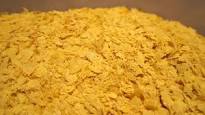
So off I went to my nearest Whole Foods market to buy some nutritional yeast. I didn’t know what it was, so I had absolutely no idea where I would find it in the store. A helpful attendant brought me to an isle in the supplement section and pointed me to both the nutritional yeast and the brewer’s yeast (yes, the same yeast that’s used in beer except that it’s been deactivated), which she told me are the same thing. I ended up buying brewer’s yeast because it was sold in the smallest container, and I didn’t want to commit to a large container of something that I didn’t expect to like.
When I got home, I opened the new container of brewer’s yeast and reluctantly tried some of the flakes that stuck to the tip of my wet finger. Hmmm. Not bad. Kind of good. In fact, very good! It had a somewhat nutty, cheesy taste. And it wasn’t anything close to the horrible yeasty concoction my mind had imagined!
So, what exactly IS nutritional yeast? Nutritional yeast is a deactivated yeast, meaning that the grown yeast has been killed by adding salt and heat, and is typically from the strain Saccharomyces (S) cerevisiae. The dead yeast are broken down into course flakes or a fine powder that can be added to sauces, soups, and gravies to impart a “cheesiness”, or sprinkled over salads, cooked vegetables, pasta, rice, or even popcorn to add a taste similar to that of parmesan cheese.
Nutritional yeast is high in protein, providing the full spectrum of amino acids (building blocks of protein) and full of B-vitamins, especially riboflavin and folate. Plus, nutritional yeast is low in sodium, and unlike real cheese, is low in fat and has no cholesterol. According to the label on my large (15.9 oz.) can of Whole Foods-brand nutritional yeast, a serving size of 2 rounded tablespoons delivers 7 grams (g) of protein, 3 g of fiber, 40 micrograms of riboflavin, and 190 micrograms of folate.
Nutritional yeast is often supplemented with vitamin B12 because unlike S cerevisiae grown in the wild that has bacteria that can produce vitamin B12, the conditions in which commercially produced nutritional yeast is grown does not allow the vitamin B12-producing bacteria to grow.
Because nutritional yeast is deactivated, or dead yeast, it cannot reproduce and infect you. Furthermore, nutritional yeast cannot cause or contribute to Candida yeast infections because not only is it deactivated, it is also derived from a different species of yeast.
If you’ve never tried nutritional yeast, I urge you to try it. You will be pleasantly surprised by how good it tastes. And I dare you to click here to try this not-so-cheesy “cheese” sauce, my favorite, and put it over elbow macaroni pasta, broccoli, a baked potato, or corn chips with a little salsa to make nachos!
Nutritional yeast. I don’t think the name does justice to the taste. I think that nutritional yeast needs a better name. What would you call it?



 RSS Feed
RSS Feed